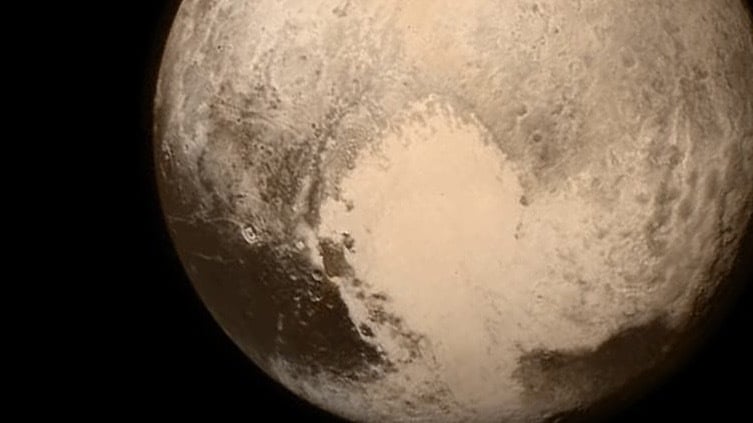Pluto’s ‘heart’ is yet another bummer for the dwarf planet

Bless Pluto’s heart.
When NASA‘s New Horizons spacecraft first snapped photos of an unusual heart-shaped scar on Pluto in 2015, the new view bolstered theories that the frigid world harbored an underground ocean.
Scientists thought the left side of the bright white heart, or Tombaugh Regio, formed after another planetary body crashed into it. The space collision may have allowed a deep reservoir of water to rise up into the chasm, intermixing with nitrogen gas from Pluto’s atmosphere, where it condensed and froze there.
But new research on the heart suggests there might not be an ocean lurking within Pluto after all. If so, this discovery would arguably add to Pluto’s list of 21st century embarrassments. Its demotion in 2006 from 9th planet in the solar system to dwarf planet lives in infamy, though Arizona Gov. Katie Hobbs apparently just signed a law making Pluto the official state planet — facts and consensus, be darned.
Astrophysicists used advanced computer simulations to try to recreate the cataclysmic event. The team was able to demonstrate that an enormous-yet-slow strike from another planetary body could have caused the heart if it were a glancing blow rather than head-on. The findings, led by the University of Bern in Switzerland, were published this month in Nature Astronomy.
Through computer models, the team learned that a collision in Pluto’s ancient history, before it was fully formed, could have caused the left side of the heart, a feature known as Sputnik Planitia. This side is roughly one-quarter the size of Europe, according to the study. The impactor would have been about as wide as Tennessee.
The researchers attribute the heart’s bright appearance to white nitrogen ice that moves heat like a convection oven and smooths out the surface. The team thinks the nitrogen would have collected in the chasm quickly after the crash because of its lower altitude.

The other side of the heart is covered by a similar layer of nitrogen ice, albeit much thinner. Though its origin is not well understood, scientists believe it’s linked to Sputnik Planitia, too.
“Pluto’s core is so cold that the rocks remained very hard and did not melt despite the heat of the impact,” said Harry Ballantyne, the lead author, in a statement, “and thanks to the angle of impact and the low velocity, the core of the impactor did not sink into Pluto’s core, but remained intact as a splat on it.”
The core of the assailant that hit Pluto is probably lying beneath Sputnik Planitia, in a “never quite digested” form, added Erik Asphaug, a co-author from the University of Arizona.

The new simulation presents an intriguing conundrum on the inner workings of Pluto. Physics should cause that depression to slowly move toward the nearest pole, but Sputnik Planitia sits near Pluto’s equator. Previous theories supposed that Pluto’s icy shell would be thinner at the impact site, causing a liquid underground ocean to bulge and drift toward the equator.
But the new study offers a different explanation that doesn’t require a subsurface ocean. In the simulations, the impact digs up all of Pluto’s primitive mantle. When the impactor’s core spattered onto Pluto’s core, it created an excess mass of material at the site that could have caused the depression to move toward the equator, according to the paper.
Since New Horizon’s close encounter with Pluto nine years ago, experts have come to think of the dwarf planet as much more scientifically valuable. Rather than a cold, featureless ball in the outer reaches of the solar system, the spacecraft images showed a geologically diverse world, with mountains, ice sheets, pits, cliffs, fissures, and valleys. But if it isn’t an ocean world, there’s still much more to learn about its past.
“The formation of Sputnik Planitia provides a critical window into the earliest periods of Pluto’s history,” said Adeene Denton, a co-author from the University of Arizona, in a statement. “By expanding our investigation to include more unusual formation scenarios, we’ve learned some totally new possibilities for Pluto’s evolution, which could apply to other Kuiper Belt objects as well.”